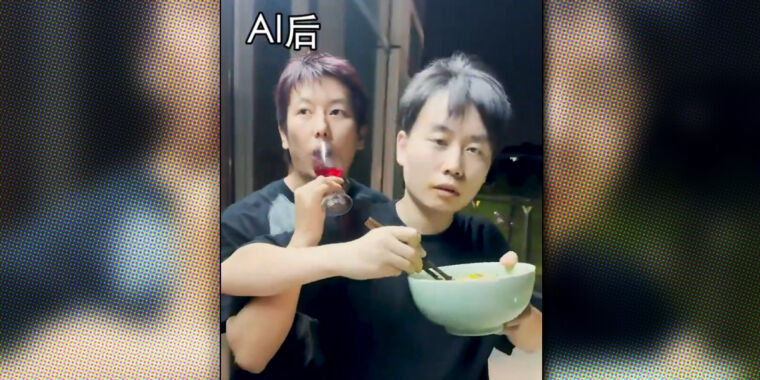Close-up / A still from a Chinese social media video featuring two people mimicking an incomplete AI-generated video output.
It's no secret that AI-generated videos sometimes fail to achieve convincing realism, despite significant investment from companies like OpenAI and Runway. Some of the most amusing fails have been posted to social media, leading to a new reaction trend on Chinese social media platforms TikTok and Bilibili, where users create videos mocking the imperfections of AI-generated content. The trend has since spread to X (formerly Twitter) in the US, where users are sharing humorous parodies.
In particular, these videos appear to be parodies of photo-composite videos in which subjects seamlessly morph into other people or objects in unexpected and physically impossible ways. Chinese social media has recreated these unusual visual discontinuities without special effects, such as by placing the subjects' bodies in unusual positions as new and unexpected objects appear on camera from outside the frame.
The exaggerated imitation struck a chord with X's viewers, who found the parody amusing. User @theGioM shared one video, shown above. “This is high level performance art,” wrote one X user. “Art imitating life, imitating AI. Almost brought me to tears.” Another user commented, “I still need that bike that transforms into a speedboat and takes off into the sky. Other than that this is a great piece.”
An example of a Chinese social media video featuring two people imitating a flawed AI-generated video output.
An example of a Chinese social media video featuring two people imitating a flawed AI-generated video output.
While these parodies poke fun at current limitations, tech companies are actively working to overcome them with more training data (examples analyzed by AI models that teach them how to create videos) and computational training time. OpenAI announced Sora in February, which can create realistic scenes when they closely match examples in the training data. Runway's Gen-3 Alpha is suffering a similar fate, as it can create convincing short video clips within limited constraints, meaning videos generated in situations outside the dataset are often hilariously weird.
AI-generated videos featuring people and animals undergoing impossible transformations, a style that social media users are emulating.
AI-generated videos featuring people and animals undergoing impossible transformations, a style that social media users are emulating.
It's worth noting that actor Will Smith got ahead of Chinese social media users in getting on board with the trend in February, when he poked fun at a horrifying AI-generated video of himself eating spaghetti in 2023. This may also bring back memories of other funny montage fails, such as Runway's AI-generated beer commercial from May 2023, which was created using the brand's previous second-generation models.
An example of a Chinese social media video featuring two people imitating a flawed AI-generated video output.
An example of a Chinese social media video featuring two people imitating a flawed AI-generated video output.
While imitating imperfect AI videos might seem odd to some, people regularly make money on TikTok by pretending to be NPCs (non-player characters, a term for computer-controlled video game characters).
Anyone alive in the 1980s would have had quite a cognitive shock witnessing this rapidly changing and often bizarre world of new media. But it is a strange place, full of unimaginable wonders. “There are more things in the heavens and the earth, Horatio, than thy philosophy ever dreamed of,” Hamlet once famously said, “including people pretending to be video-game characters, and faulty video-composite output.”

